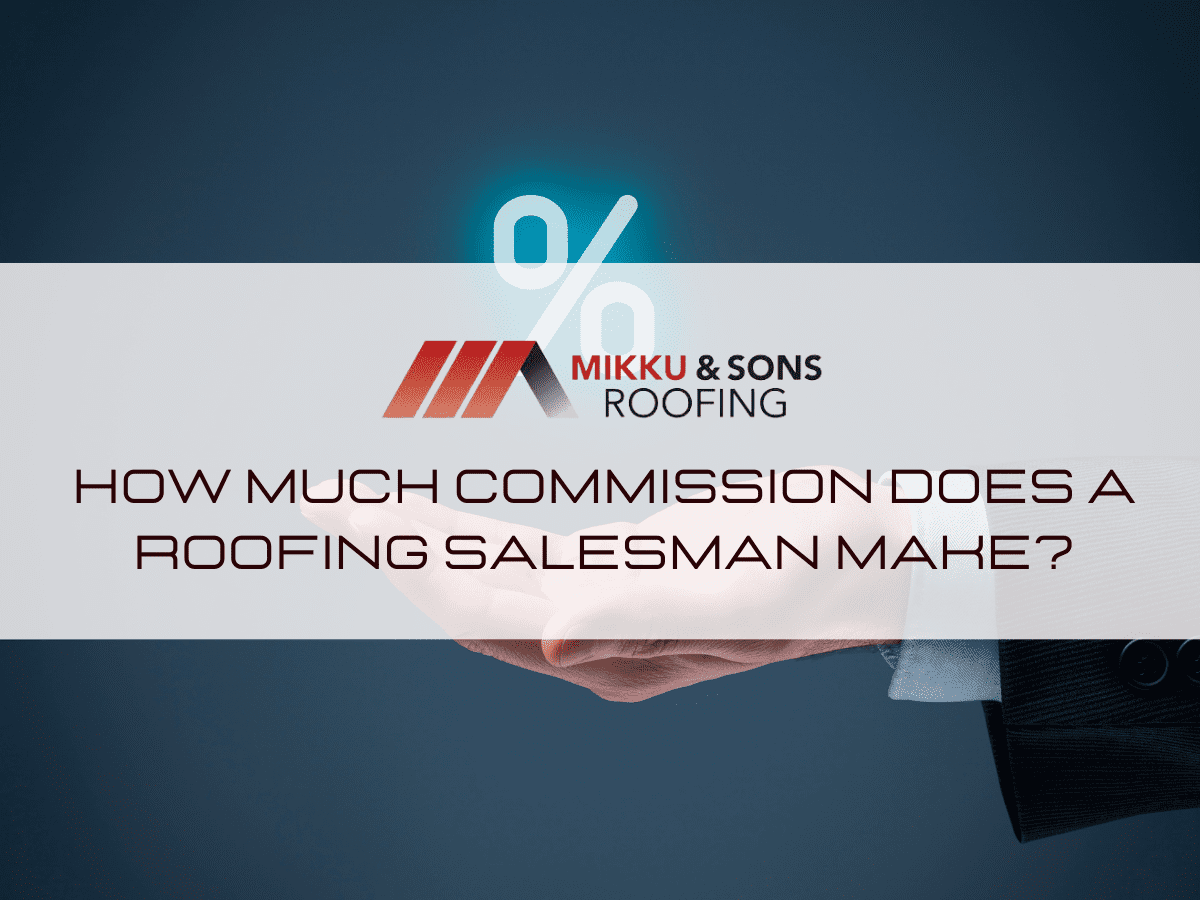
A roofing salesperson receives between 8% and 12% of the total collected, depending on commission structure and administrative charges, despite the fact that there are additional variables to consider, the majority of which will be covered below.
How much commission does a roofing salesman make? A roofing salesperson often receives between 8 and 12 percent of the total amount collected, depending on your compensation plan and administrative charges.
First, we need to understand the two types of commission structures. We have commissions that are based on either:
Here’s the difference.

The top-line figures are referred to as the percentage of sales. I'll use round numbers to demonstrate this in the example below. They are preliminary estimations that do not match industry standards. Keep in mind that these norms vary depending on the market, the industry, and the profit margin goals of each organization. So, we'll just use some arbitrary approximate figures here.
As an example, let's say I sell a $10,000 roof. That is the contract price of $10,000. The percentage of sales will often range between 7 and 12%. Assume it's 10%. In this situation, the commission would be $1,000. A $1,000 commission on a $10,000 contract? Done.
Why is this % range present? Two factors:
Typically, percentage-of-profit commissions range between 30 and 50 percent. Now, if you're a (n):
I would suggest that you not pay 50%. This is due to the corporation's massive responsibility for this installation. I've discovered that when a higher commission is paid, the majority of enterprises fail. I wouldn't do it unless the person is a high-volume producer.
When you are paid a percentage of sales, you must constantly focus on recruiting new customers. To receive your commission, you must make as many sales as possible. This is how you should approach the situation because the salesperson will be exclusively accountable for generating new revenue through contract signing.
The assignment is then frequently assigned to a production team, which meets with the adjuster. The labor order, manufacturing, and augmentation will be handled by someone else.
If you are compensated based on a proportion of gross sales, you should pursue volume. Do the math if you want to earn $100,000 every year. To earn $100,000, you would need to sell one million dollars.
To illustrate the operation of percentage-of-profit commissions, I will utilize the same $10,000 contract. After making a sale, the majority of roofing firms will deduct an "overhead percent."
This ranges between 10 and 15 percent. This is the cost of maintaining office lighting, employing office personnel, and purchasing liability insurance. This includes the internet bill, administrative employees, phone lines, the internet, and marketing costs, among other things.
Therefore, we will deduct 10 to 15% for overhead. That is typical and expected. If overhead is 10%, that would be $1,000. Now, we're down to $9,000.
From the $9000, we will need to cover all expenses, including labor and materials, permits, and anything else related to constructing the roof. If everything costs $6,000 (again, these are just arbitrary amounts), we would be left with $3,000.That's a profit of $3,000. I will utilize 40% of the range between 30% and 50% for this percentage commission. That would be a commission of $1,200.
A commission structure specifies how corporations compensate their sales staff in the sales sector. Various sales commission models result in varying levels of remuneration.
Commissions may be paid weekly, bimonthly, or monthly. Most are paid at the end of the period, but some may be delayed if employers must wait for client payments before paying you.
Importance of an effective commission structure
Fairness and accuracy are important concerns for businesses when developing a successful commission structure. Sales employees who believe they are being adequately compensated are more inclined to stay with a company rather than leave for greater chances.
Effective arrangements contain a good blend of wage and commission and quotas that may be met. How a firm compensates its salespeople can impact profitability while attracting and retaining the greatest sales force.

Businesses use a range of sales commission models depending on their services or products. The following are the nine most prevalent structures
Sales personnel are paid hourly or flat compensation under the base rate-only scheme. This incentive system is advantageous for firms when salespeople spend a significant amount of time educating and helping customers both before and after the sale. There is no motivation to upsell or sell additional goods or services.
For instance, the company's four salespeople each get $1,250 every week, regardless of how many sales they generate. Because no commission is paid, no calculation is required.
2. Base salary plus commission
It pays salespeople an hourly or fixed base income plus a commission rate. The base wage is frequently too little to cover someone's whole income, although it does give a fixed income when sales are poor.
The typical salary-to-commission ratio is 60:40, with 60% being base pay and 40% being commission-based. The plan works best as an incentive or motivation to improve sales performance.
Example: A salesperson earns $500 per month in salary plus a 10% commission on sales of $5,000 or more. If he sells $20,000 in one month, he will make $2,500: $500 in salary and $2,000 in commission. Commission calculation with merely the base rate:
Commission Total = Commission Percentage x Amount Sold.
3. Draw against a commission.
In order to help new hires get used to their sales duties without causing a dip in income, the commission draw plan is based on early payment or draw. It incorporates aspects of both the commission-only and the base salary plus commission structures. The more you sell, the more commissions you earn.
Sales agents are paid a monthly income or draw, regardless of sales volume. If they make less in commission than they do in pay, they keep the commission as well as the difference. The monies are considered forward payments until commissions equal or surpass the salary drawn.
Employers must eventually be reimbursed for these upfront payments. Only when commission totals exceed the draw amount does the salesperson benefit.
Example: A salesman is supposed to make $4,000 in commission and $2,000 in draw per month. If they reach their $4,000 target, they will receive an additional $2,000, the amount over the draw. If they only earn $1,000, they owe the firm $1,000, which is the amount of the draw.
Draw commission is calculated as follows:
Commission Total - Draw = Commission Owed.
4. Gross margin commission
The gross margin commission model accounts for the costs of the products being sold. The salesperson is paid a percentage of the profit. Salespeople are less likely to cut corners because their pay is based on the final cost of the sale. The more money they can make by upselling a product or service.
Assume a salesperson is selling a $100,000 automobile that costs $60,000 to produce. The gross profit margin is $40,000 each year. The salesperson is paid 5% of the profit margin, which amounts to $200.
Calculating the gross margin commission:
Total Sale Price - Cost Equals Gross Margin Gross Margin x Commission Percentage Equals Total Commission.
5. Residual commission
The residual plan benefits salespeople who have repeat customers or clients. Commission payments will continue indefinitely as long as accounts generate revenue. Salespeople are pushed by the framework to retain or acquire repeat customers. This structure is especially common in long-term account agencies and consulting firms.
An insurance salesperson, for example, wins a large account. The salesman receives a 5% commission, or $150 per month, as long as the corporation pays its $3,000 monthly premiums.
Calculation of the remaining commission:
Payment x Commission Percentage = Total Commission.
6. Revenue commission
When determining commission rates, companies that are more concerned with wider company goals than overall profit sometimes adopt the revenue commission model. Top sales performers are sales reps who get a predetermined percentage of the income they create.
For example, a car salesperson earns 3% of the sale of a $25,000 automobile. For such a sale, they receive a revenue commission of $750.
Revenue commission calculation:
Total Commission = Sale Price x Commission Percentage.
7. Straight commission
Straight commission salespeople only make money when they make a deal. There will be no money if no sales are made. Because there is no base income, the corporation may give greater commission rates, which generally attracts the finest salesmen. The straight commission structure allows salespeople to work as independent contractors, setting their own hours and saving organizations money on taxes, benefits, and other expenses. The company only loses money when the salesman really brings in money.
For instance, a telemarketer who promotes holiday condo rentals makes $150 for each booking. The more time spent on the phone, the more likely it is that a transaction will be made.
Straight commission calculation:
Sales x Commission Rate = Income.
8. Tiered commission
Salespeople in the tiered commission model earn a set percentage of commission on all sales up to a specified amount. When they reach their revenue target, their commission grows. This motivates them to outperform their sales targets and close more agreements.
For instance, a salesperson's basic compensation is 5% up to $100,000 in sales. For total sales between $100,000 and $200,000, the commission rises to 7%. Any sales in excess of $200,001 earn them a 10% commission.
9. Territory volume commission.
Salespeople in this strategy are paid depending on the fixed rate for their defined region. The amount of remuneration is usually determined by territorial volume, in which sales figures are tallied, and commissions are divided evenly among salespeople in the region. This pay plan only applies to sales professionals working in a team environment.
Example: Two salespeople are supposed to sell $50,000 in merchandise in a 100-mile radius each month. One sells $30,000, while another sells $20,000. They divided the 10% commission, receiving $2,500 apiece because the overall target was accomplished.
The territorial volume commission is calculated using a variety of parameters based on the company's sales algorithms. A quick calculation would be:
Total Sales x Commission Percentage divided by Total Salespeople = Commission per Person.
One of the most significant things a company can do for its sales operation is to define its commission structure. What works best for one company may not be the ideal solution for another. Here are some pointers for determining the best commission plan for your business:
Sales often have a high turnover rate, so don't hesitate to experiment with alternative incentive schemes. What was motivating five years ago may no longer be motivating today's sales teams.
The average monthly salary for a Roofing Sales Representative in the United States is $6,664 as of September 5, 2022. While ZipRecruiter reports monthly earnings as high as $11,250 and as low as $1,625, the majority of Roofing Sales Representative salaries in the United States now vary from $4,958 (25th percentile) to $8,041 (75th percentile).
A Roofing Sales Representative's average salary range varies substantially (up to $3,083), implying that there may be several prospects for promotion and increased income based on skill level, location, and years of experience.
Roofers in the United States earn an average of $23.90 per hour and $6,375 per year in overtime. 3.1k salaries were recorded as of September 9, 2022.
In the roofing industry, typical roofing companies earn between 20% and 40% gross profit. The number for service-oriented businesses could be higher, while the number for new development and major commercial businesses could be lower.

The work of a roofer requires considerable physical strength and stamina. It takes fortitude to keep one's footing and move confidently, whether standing, climbing, or walking in temperatures above or below freezing, in heavy winds or snow, or in the pouring rain. Roofing contractors ensure that their clients' facilities are secure for any employees or valuables housed therein.
